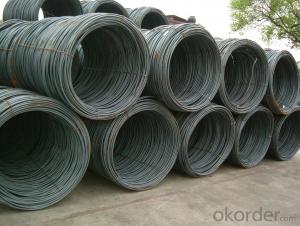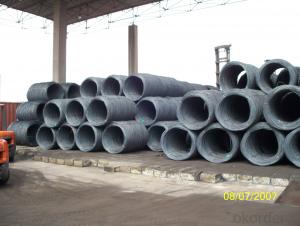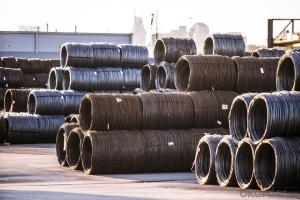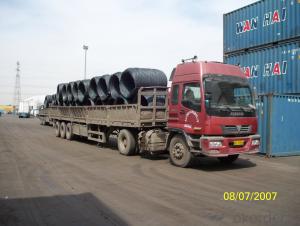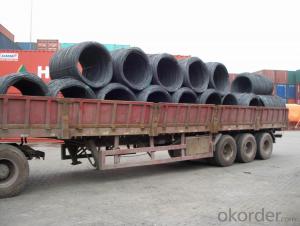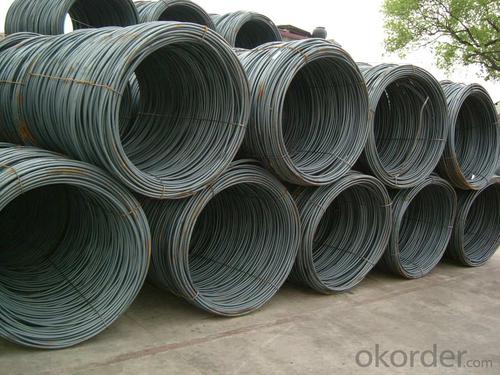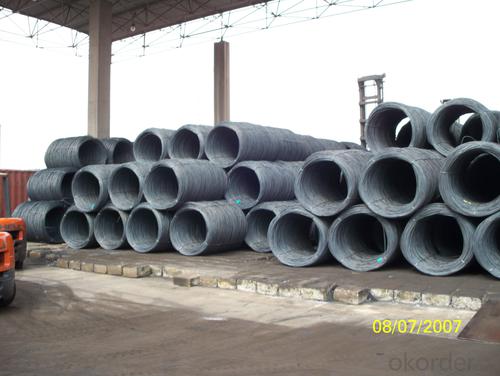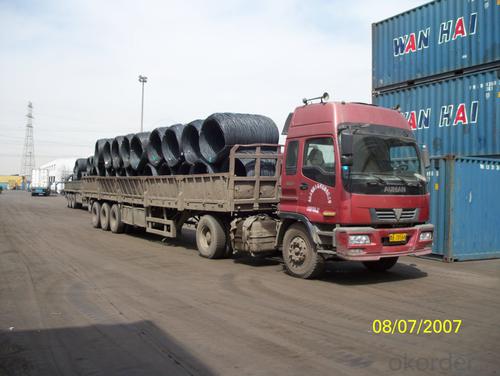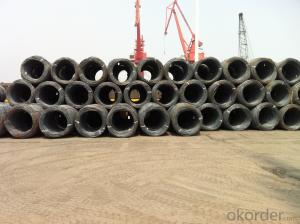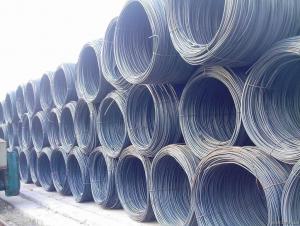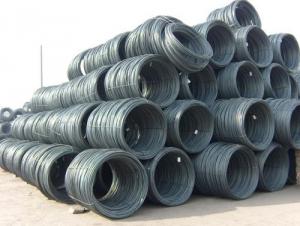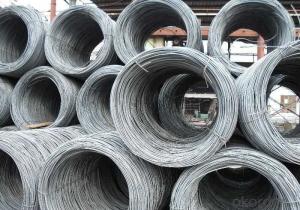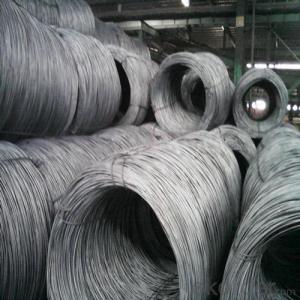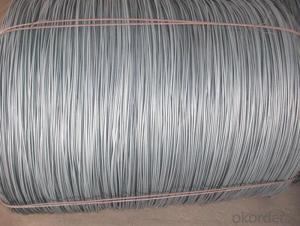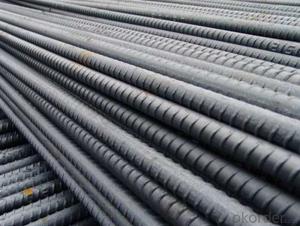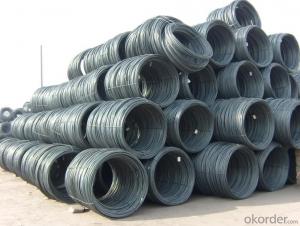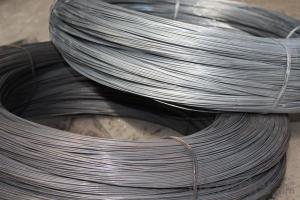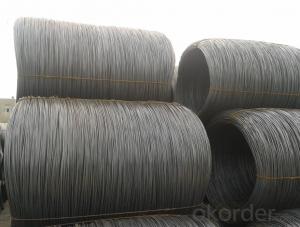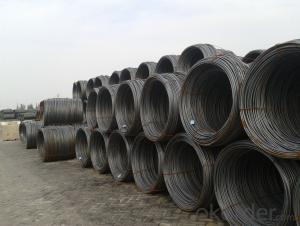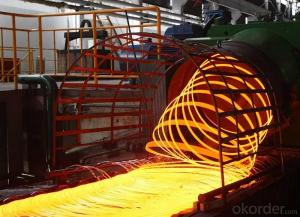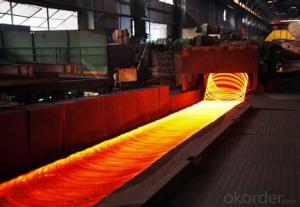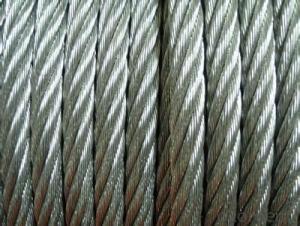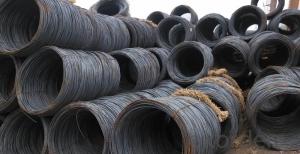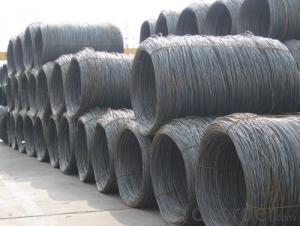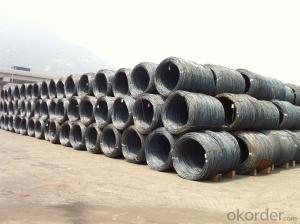SAE1006Cr Carbon Steel Wire Rod 7mm for Welding
- Loading Port:
- Shanghai
- Payment Terms:
- TT OR LC
- Min Order Qty:
- 100 m.t
- Supply Capability:
- 30000 m.t/month
OKorder Service Pledge
OKorder Financial Service
You Might Also Like
Specification
Description of SAE1006Cr Carbon Steel Wire Rod 7mm for Welding:
OKorder is offering Color Coated Steel Coil Prepainted Steel Coil at great prices with worldwide shipping. Our supplier is a world-class manufacturer of steel, with our products utilized the world over. OKorder annually supplies products to European, North American and Asian markets. We provide quotations within 24 hours of receiving an inquiry and guarantee competitive prices.
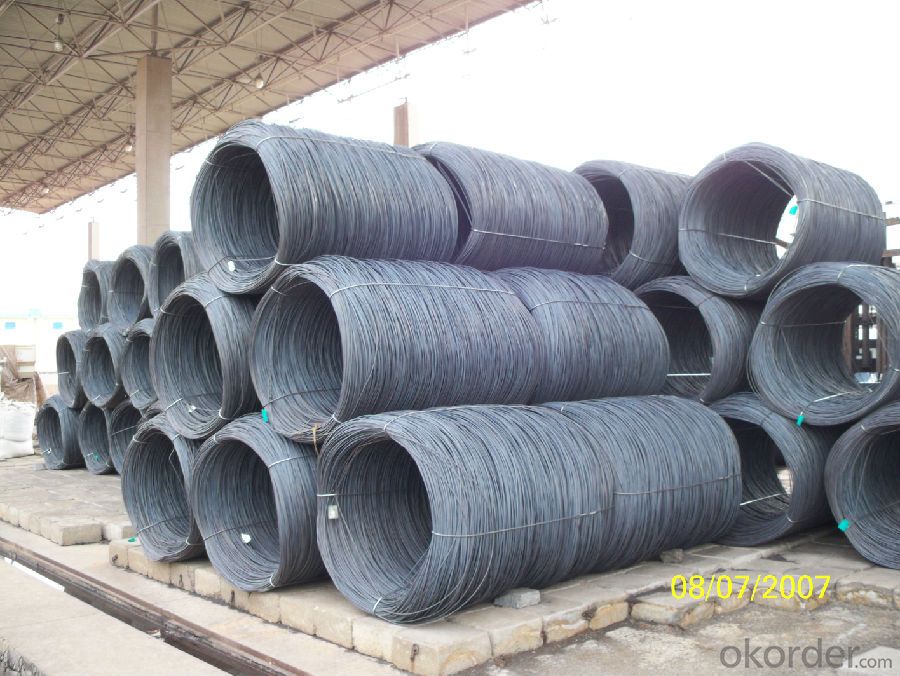
Applications of SAE1006Cr Carbon Steel Wire Rod 7mm for Welding:
Color Coated Steel Coil Prepainted Steel Coil are ideal for structural applications and are widely used in the construction of buildings and bridges, and the manufacturing, petrochemical, and transportation industries.
Main Product Features of SAE1006Cr Carbon Steel Wire Rod 7mm for Welding:
· Premium quality
· Prompt delivery & seaworthy packing (30 days after receiving deposit)
· Corrosion resistance
· Can be recycled and reused
· Mill test certification
· Professional Service
· Competitive pricing
Specifications of SAE1006Cr Carbon Steel Wire Rod 7mm for Welding:
PPGI:
1, Introduction: Color coated steel coils(sheets), i. E. PPGI, also called prepainted steel coils(sheets), are made of galvanized steel coils(sheets) with polymer coatings as surface. It's a new enclosure material and building board with characteristics of light-weighted, heat preserved&insulated, easily installed with bright colors.
2, Production Process: Pretreatment(Degreasing)_Drying_Chromating_Paint Basic Oil_Cooling_Drying_Color Coating_Cooling_Film-covering_Rolling Up
3, Characteristics:
Good at corrosion resistence. Besides zinc coating of the basic plate of galvanized steel sheet, the color coating as the surface has double lifetime to ensure better anticorrosion effect.
With excellent cold bending molded manufacturablity, PPGI products can be processed or directly used as final product. As being light-weighted and conveniently transported, they're widly used to replace wood to save energy.
4.There're thousands of colors can be chosen as per different application. Any color plays well in decoration.
No pollution with high recycling rate, PPGI coils and sheets are strongly recommended as enviroment-friendly products by the government.
5, eye bands and 4 circumferential bands in steel, galvanized metal fluted rings on inner and outer edges, galvanized.
| commodity | SAE1006Cr Carbon Steel Wire Rod 7mm for Welding |
| Techinical Standard: | JIS G3302-1998, EN10142/10137, ASTM A755 |
| grade | Q195,Q215,Q235,SAE1006,SAE1008 SAE1006Cr |
| Types: | Mesh welding |
| Base metal | galvanized, galvalume, cold rolled steel |
| Thickness | 0.14-1.0mm(0.16-0.8mm is the most advantage thickness) |
| Width | 610/724/820/914/1000/1200/1219/1220/1250mm |
| Type of coating: | PE, SMP, PVDF |
| Zinc coating | Z60-150g/m2 or AZ40-100g/m2 |
| Top painting: | 5 mic. Primer + 15 mc. R. M. P. |
| Back painting: | 5-7 mic. EP |
| Color: | According to RAL standard |
| ID coil | 508mm610mm |
| Coil weight: | 2--3MT |
| Package: | Properly packed for ocean freight exportation in 20'containers |
| Application: | Industrial panels, roofing and siding for painting/automobile |
| Price terms | FOB, CFR, CIF |
| Payment terms | 20%TT in advance+80% TT or irrevocable 80%L/C at sight |
| delivery time | 25 days after recepit of 20% TT |
| Remarks | Insurance is all risks |
| MTC 3.1 will be handed on with shipping documents | |
| We accept SGS certificatation test |
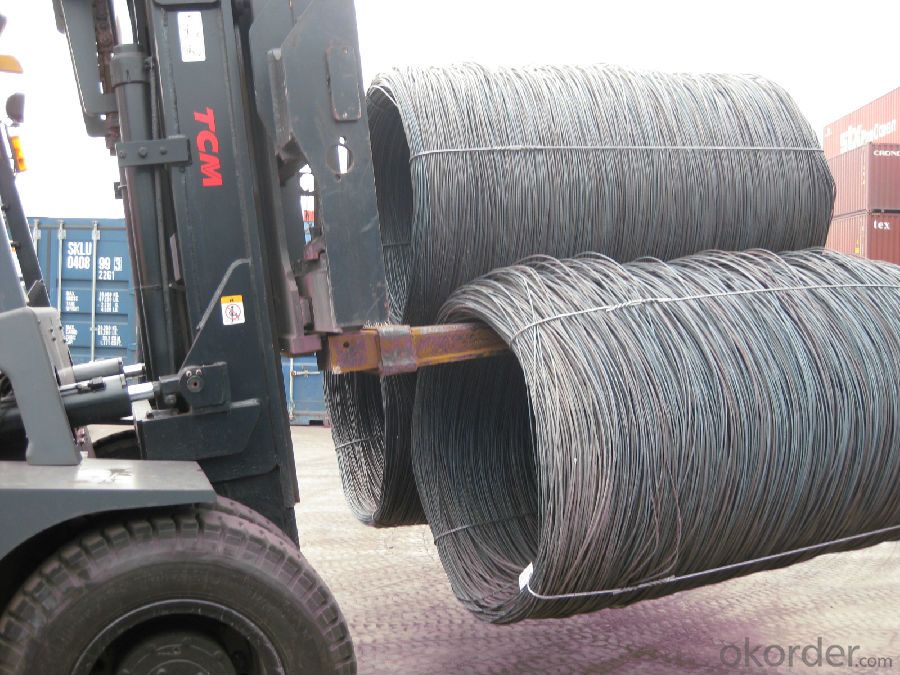
FAQ of SAE1006Cr Carbon Steel Wire Rod 7mm for Welding:
Q1: Why buy Materials & Equipment from OKorder.com?
A1: All products offered byOKorder.com are carefully selected from China's most reliable manufacturing enterprises. Through its ISO certifications, OKorder.com adheres to the highest standards and a commitment to supply chain safety and customer satisfaction.
Q2: How do we guarantee the quality of our products?
A2: We have established an advanced quality management system which conducts strict quality tests at every step, from raw materials to the final product. At the same time, we provide extensive follow-up service assurances as required.
Q3: How soon can we receive the product after purchase?
A3: Within three days of placing an order, we will begin production. The specific shipping date is dependent upon international and government factors, but is typically 7 to 10 workdays.
Q4: What makes stainless steel stainless?
A4: Stainless steel must contain at least 10.5 % chromium. It is this element that reacts with the oxygen in the air to form a complex chrome-oxide surface layer that is invisible but strong enough to prevent further oxygen from "staining" (rusting) the surface. Higher levels of chromium and the addition of other alloying elements such as nickel and molybdenum enhance this surface layer and improve the corrosion resistance of the stainless material.
Q5: Can stainless steel rust?
A5: Stainless does not "rust" as you think of regular steel rusting with a red oxide on the surface that flakes off. If you see red rust it is probably due to some iron particles that have contaminated the surface of the stainless steel and it is these iron particles that are rusting. Look at the source of the rusting and see if you can remove it from the surface.
- Q: How is steel wire rod used in the manufacturing of medical devices?
- Steel wire rod is used in the manufacturing of medical devices in various ways. It can be shaped and formed into different components such as springs, coils, and meshes, which are essential for the functionality and structural integrity of medical devices. Additionally, steel wire rod is often used as a reinforcement material in surgical instruments, catheters, and orthopedic implants, providing strength and durability to these devices.
- Q: How does the magnetic properties of steel wire rod vary with different heat treatment processes?
- The magnetic properties of steel wire rod can greatly differ depending on the heat treatment processes used. Heat treatment involves subjecting the rod to controlled heating and cooling to change its microstructure, which in turn affects its magnetic properties. One commonly used heat treatment process for steel wire rod is annealing. Annealing involves heating the rod to a specific temperature and then slowly cooling it to room temperature. This process helps relieve internal stresses, refine the grain structure, and enhance the ductility of the wire rod. In terms of magnetic properties, annealing decreases the magnetic permeability of the rod, making it less vulnerable to magnetic fields. This can be advantageous in applications where minimizing magnetic interference is important. Another heat treatment process for steel wire rod is quenching and tempering. Quenching involves rapidly cooling the wire rod from a high temperature to room temperature, usually by immersing it in a quenching medium like oil or water. This rapid cooling results in a hard and brittle structure called martensite. However, martensite is not magnetic and has low ductility. To improve the ductility and toughness of the wire rod, tempering is performed by reheating the quenched wire rod to a lower temperature and then allowing it to cool slowly. The tempering process partially transforms the martensite into a more ductile structure known as tempered martensite. The magnetic properties of the wire rod after quenching and tempering can vary depending on the composition and cooling rate during quenching, as well as the temperature and duration of the tempering process. In conclusion, different heat treatment processes can significantly affect the magnetic properties of steel wire rod. Annealing reduces the magnetic permeability, while quenching and tempering modify the microstructure and magnetic behavior of the rod. The choice of specific heat treatment process depends on the desired magnetic properties and the intended application of the steel wire rod.
- Q: What are the different types of steel wire rod coatings used for improved wear resistance?
- Steel wire rod coatings have several types that are commonly used to improve wear resistance. These coatings are applied to the surface of the steel wire rod to provide a protective layer that enhances durability and extends lifespan. Some of the various coatings include: 1. Galvanization: Zinc coating, also known as galvanization, is widely used for steel wire rods. It provides excellent corrosion resistance and protects the steel from rust and environmental factors. The zinc coating acts as a sacrificial layer, preventing direct contact with the elements. 2. Polymer Protection: Polymer coatings are applied to steel wire rods to provide an extra layer of protection against wear and tear. These coatings are typically made from different types of polymer materials, such as polyethylene or polypropylene. Polymer coatings offer good resistance to abrasion and can withstand harsh operating conditions. 3. Exceptional Adhesion: Epoxy coatings are popular for their exceptional adhesion and chemical resistance properties. They form a strong bond with the steel wire rod surface, creating a protective barrier against wear, abrasion, and corrosion. Epoxy coatings are commonly used in applications where the wire rod is exposed to chemicals or harsh environments. 4. Enhanced Lifespan: Ceramic coatings are highly resistant to wear and greatly enhance the lifespan of steel wire rods. They are made from ceramic materials, such as aluminum oxide or zirconium oxide, which provide excellent hardness and heat resistance. Ceramic coatings are often used in high-stress applications where the wire rod is subjected to extreme temperatures and abrasive conditions. 5. Corrosion Resistance: Nickel coatings offer excellent corrosion resistance and are often used to protect steel wire rods from environmental degradation. They provide a smooth and uniform layer that prevents oxidation and rust formation. Nickel coatings can also enhance the aesthetic appearance of the wire rod. In conclusion, the choice of steel wire rod coating depends on specific application requirements, such as operating conditions, expected wear and tear, and environmental factors. Each type of coating offers unique benefits in terms of wear resistance and protection, enabling manufacturers to select the most suitable coating for their specific needs.
- Q: What are the common forming techniques used for steel wire rod?
- The common forming techniques used for steel wire rod include drawing, rolling, and extrusion.
- Q: What are the different types of steel wire rod surface treatment chemicals?
- There are several different types of steel wire rod surface treatment chemicals that are commonly used in various industries. These chemicals are designed to enhance the properties of the steel wire rod and provide protection against corrosion. Some of the most common types of surface treatment chemicals include: 1. Phosphating chemicals: Phosphating is a common surface treatment process that involves the application of a phosphate coating to the steel wire rod. This coating helps improve the adhesion of paints and other coatings, provides corrosion resistance, and enhances the overall appearance of the wire rod. 2. Pickling chemicals: Pickling is a process that involves the removal of scale and oxides from the surface of the steel wire rod. Pickling chemicals, such as hydrochloric acid or sulfuric acid, are used to dissolve these impurities and leave a clean and smooth surface. 3. Passivation chemicals: Passivation is a chemical process used to remove free iron or iron oxide from the surface of the steel wire rod. This helps to enhance the corrosion resistance of the wire rod by creating a protective oxide layer. 4. Chromate conversion coatings: Chromate conversion coatings are often used as a post-treatment for phosphating or pickling processes. These coatings provide additional corrosion resistance and improve the adhesion of paints or other coatings. 5. Anti-corrosion oils: Anti-corrosion oils are applied to the surface of the steel wire rod to provide temporary protection against corrosion during storage or transportation. These oils form a thin film that helps to prevent moisture and other corrosive substances from reaching the surface of the wire rod. It is important to note that the choice of surface treatment chemical depends on the specific requirements of the steel wire rod and the intended application. Different industries may have their own unique set of requirements and may use different types of surface treatment chemicals accordingly.
- Q: What are the main factors influencing the choice of steel wire rod warranty?
- The choice of steel wire rod warranty is influenced by several key factors. Firstly, the quality of the steel wire rod is crucial. Buyers prefer a high-quality product that is unlikely to have defects or issues, reducing the need for warranty claims. Factors such as strength, durability, and overall performance play a significant role in determining confidence in the product and, consequently, the warranty. Secondly, the reputation of the manufacturer is another important consideration. Buyers are more likely to trust a manufacturer with a proven track record of producing high-quality steel wire rods and providing reliable warranties. Positive reviews, testimonials, and references from other customers can provide valuable insights into the manufacturer's commitment to customer satisfaction and after-sales service. Lastly, the terms and conditions of the warranty itself are essential. Buyers carefully consider factors such as the duration of the warranty, the extent of coverage it offers, and any limitations or exclusions stated in the warranty documentation. A longer warranty period and comprehensive coverage, including protection against manufacturing defects or premature failure, are often preferred. Additionally, factors such as the process for filing warranty claims, the responsiveness of the manufacturer's customer service, and the ease of warranty fulfillment are also taken into account. To summarize, the main factors influencing the choice of steel wire rod warranty are the quality of the product, the reputation of the manufacturer, and the terms and conditions of the warranty. Buyers prioritize a high-quality product, a reputable manufacturer, and a warranty with favorable terms and comprehensive coverage.
- Q: How is the demand for steel wire rod influenced by global economic trends?
- The demand for steel wire rod is significantly influenced by global economic trends. As steel wire rod is a critical raw material used in various industries such as automotive, construction, and manufacturing, any changes in the global economic landscape can have a direct impact on its demand. During periods of economic growth and industrial expansion, the demand for steel wire rod tends to increase. This is because increased construction activities, infrastructure development, and manufacturing output require large quantities of steel wire rod for applications such as reinforcement in concrete, electrical wiring, and fasteners. Conversely, during economic downturns or recessions, the demand for steel wire rod tends to decline. Reduced construction projects, lower consumer spending, and decreased manufacturing activities result in a decreased need for steel wire rod. Industries that heavily rely on steel wire rod, such as automotive and construction, often experience a decline in demand during such periods. Global economic trends also play a crucial role in determining the prices of steel wire rod. Fluctuations in currency exchange rates, trade policies, and supply and demand dynamics can impact the cost of raw materials, transportation, and production, which in turn affects the price of steel wire rod. For instance, increased trade tensions between countries can lead to tariffs or trade restrictions, affecting the availability and cost of steel wire rod in global markets. Additionally, global economic trends can influence the geographical distribution of steel wire rod production and consumption. As countries experience shifts in economic growth, emerging markets may witness a surge in demand for steel wire rod due to their expanding infrastructure and construction activities. This can lead to a redistribution of production facilities and investments in these regions to cater to the growing demand. Overall, the demand for steel wire rod is strongly influenced by global economic trends. Understanding these trends and their impact on industries that rely on steel wire rod is crucial for stakeholders in the steel industry to effectively manage their production, pricing, and market strategies.
- Q: How are surface defects in steel wire rod repaired?
- Different methods can be used to repair surface defects in steel wire rods, depending on the type and extent of the defect. Common defects include scale, cracks, pits, and scratches. The following are some techniques used to address these defects: 1. Grinding and polishing: Scratches and pits can be repaired through grinding and polishing. This involves removing the damaged layer of steel and using abrasive tools to smooth the surface. The process is repeated until the defect is completely eliminated, and the surface achieves the desired finish. 2. Heat treatment: Heat treatment can be employed to repair cracks. This method involves subjecting the steel wire rod to controlled heating and cooling processes, which alter its physical and mechanical properties. Heat treatment helps close the cracks and enhance the overall integrity of the wire rod. 3. Mechanical removal: Mechanical removal methods are used for larger defects like scale or excessive surface irregularities. Specialized tools or machinery are utilized to physically remove the defective portion of the wire rod. The remaining surface is then treated to ensure it meets the required specifications. 4. Chemical treatment: Chemical treatment methods can be utilized to repair surface defects such as rust or corrosion. Appropriate chemicals or coatings are applied to the affected area to remove the corrosion and prevent further deterioration. The treated surface is then cleaned and prepared for further processing or use. It should be noted that the repair process for surface defects may vary depending on the specific requirements and standards of the steel wire rod industry. Manufacturers and technicians adhere to industry guidelines and quality control measures to ensure the repaired wire rods meet the necessary specifications for their intended applications.
- Q: What are the main factors influencing the choice of steel wire rod after-sales service?
- The main factors influencing the choice of steel wire rod after-sales service include the quality and reliability of the product, the responsiveness and effectiveness of the after-sales support team, the availability and accessibility of spare parts, the reputation and track record of the manufacturer, and the overall cost-effectiveness of the after-sales service package.
- Q: What are the factors that affect the mechanical properties of steel wire rod?
- The mechanical properties of steel wire rods are influenced by several factors. 1. Composition: The chemical composition of steel, including the presence of alloying elements such as carbon, manganese, silicon, and others, determines its mechanical properties. Different compositions result in varying levels of strength, toughness, and ductility. 2. Microstructure: The microstructure of steel, including grain size and distribution, also affects its mechanical properties. Fine-grained steels generally exhibit higher strength and improved toughness compared to coarser-grained ones. Heat treatment processes can be used to control the microstructure and enhance desired properties. 3. Heat treatment: Various heat treatment processes, such as annealing, quenching, and tempering, can significantly alter the mechanical properties of steel wire rods. These processes modify the structure and hardness of the material, providing desired levels of strength, hardness, and ductility. 4. Processing conditions: The mechanical properties of steel wire rods can also be influenced by the processing conditions during manufacturing. Factors such as the temperature, rate of cooling, and deformation applied during rolling, drawing, or extrusion processes can affect the final properties. Proper control of these parameters is crucial to achieving the desired mechanical properties. 5. Surface finish: The surface condition of steel wire rods can impact their mechanical properties. A smooth and clean surface is generally preferred as it reduces the likelihood of cracks, improves fatigue resistance, and enhances overall performance. 6. Impurities and defects: The presence of impurities, such as sulfur, phosphorus, and non-metallic inclusions, can negatively impact the mechanical properties of steel wire rods. Similarly, manufacturing defects like cracks, voids, and inhomogeneities can weaken the material and reduce its strength. 7. Environmental factors: The environment in which steel wire rods are used can affect their mechanical properties. Variables such as temperature, humidity, exposure to corrosive substances, and mechanical loading conditions can all influence the material's behavior, including its strength, ductility, and corrosion resistance. In conclusion, the mechanical properties of steel wire rods are influenced by factors such as composition, microstructure, heat treatment, processing conditions, surface finish, impurities, defects, and environmental factors. Understanding and controlling these factors are crucial in producing steel wire rods with desired mechanical properties for various applications.
Send your message to us
SAE1006Cr Carbon Steel Wire Rod 7mm for Welding
- Loading Port:
- Shanghai
- Payment Terms:
- TT OR LC
- Min Order Qty:
- 100 m.t
- Supply Capability:
- 30000 m.t/month
OKorder Service Pledge
OKorder Financial Service
Similar products
Hot products
Hot Searches
Related keywords
